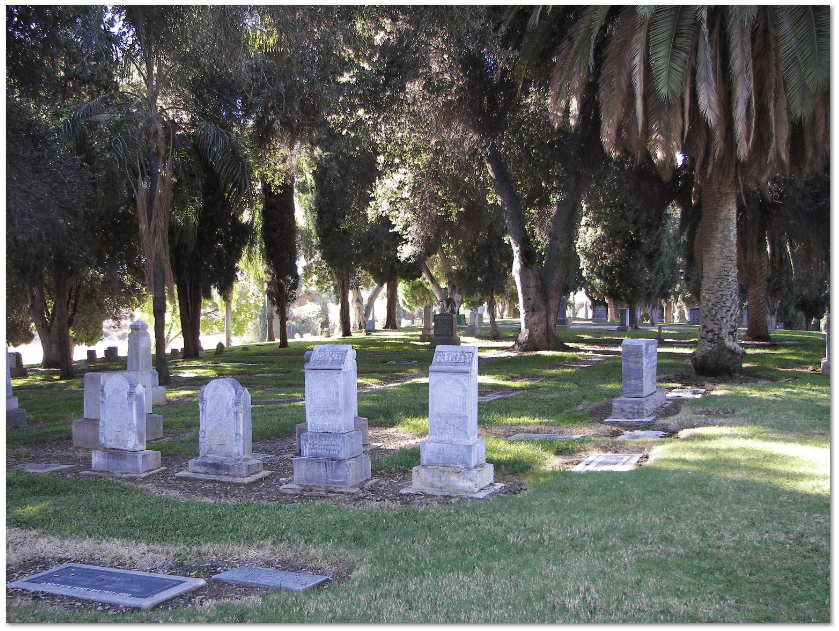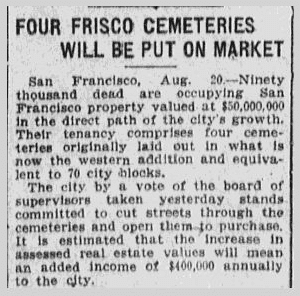Introduction: Gena Philibert-Ortega is a genealogist and author of the book “From the Family Kitchen.” In this guest blog post, Gena writes about the challenge of locating your ancestor’s burial place—and explains how to find out if a cemetery has been moved.
Most genealogy articles written about cemeteries focus on how to find your ancestor’s final resting place. These articles describe resources available (both online and off) for finding cemetery transcriptions and obituaries. Having written a book about cemeteries in a region of California, I am always amazed when we are able to find an ancestor’s burial place. Sometimes our ancestors are not buried where we think they should be.

What can you do when there seems to be no mention of an ancestor’s burial place in any resource? Not all cemeteries are places of eternal slumber. For a variety of reasons cemeteries may be repurposed, burials may be disinterred, and grave markers may be stolen or succumb to the elements over time. In my own years of genealogy research I have seen cemeteries reclaimed by nearby lakes and rivers, plowed over for golf courses, grave markers destroyed by vandals, and cemeteries repurposed for city projects. If you are able to visit the grave of an ancestor, consider yourself lucky.
We often think of newspapers as a place to read articles specific to an ancestor’s burial such as obituaries and funeral notices—but what if you need to know more about a cemetery? Old newspapers are a great place to learn about the history of a specific cemetery, or information about cemeteries in a city. Need historical background to help you ascertain whether an ancestor could be buried in a particular cemetery? Curious what happened to a cemetery? Looking for a cemetery history? Newspapers can provide this type of historical information.
Where did the cemetery go? A San Francisco newspaper example.
While the examples of what can happen to a cemetery are endless, let’s look at one well-known example of how a whole city decided that they would move their dead.
Have a 19th century ancestor that lived in San Francisco? It makes sense that they would be buried there—and they may have been, but only temporarily. In the early 20th century, San Francisco decided that its real estate was too valuable to be “wasted” on the dead.

San Francisco outlawed cemeteries, and later cremation, within its city limits. To accommodate their dead, San Francisco residents reinterred family members’ bodies in the nearby city of Colma. It’s interesting to note that Colma’s motto is “It’s great to be alive in Colma” and that’s true since it has 1,400 living residents and 1.5 million buried.*
What happens when a city decides to evict its dead? Family members of the deceased were contacted and legal notices were included in newspapers. Effort was made to contact family members of the deceased so that alternative arrangements could be made. In a case of one of my cousins, her family saw to it that their great-grandmother was reinterred in Sacramento along with a new marker. What happened to those deceased who were not claimed by kin? Their gravestones were used in building projects such as the construction of seawalls. Unidentified remains were placed in mass graves.
Not every cemetery in the city was repurposed; there are two cemeteries still in existence in San Francisco: San Francisco National Cemetery and the graveyard at Mission Dolores. There is also the Columbarium, which was once a part of the Odd Fellows Cemetery. (A columbarium is a room with niches that hold funeral urns.)
San Francisco isn’t the only example of a city moving the dearly departed to make room for other projects. In Whittier, California, the Mount Olive/Broadway Cemetery was turned into a public park called “Founder’s Park.”
As you search for the burial place of your ancestor, consider what time may have done to the cemetery. Acts of nature, the deterioration of time, city council decisions, or criminal acts may have destroyed the cemetery or gravestone, or at least made it impossible to identify where your ancestor is buried. Before you decide that it is hopeless to find your ancestor’s burial place, take time to research the history of the area—which in turn can help you better understand the cemeteries in that area.
To read more about San Francisco’s cemeteries and Colma see the book Colma (Images of America series) by Michael Smookler.
* From Town of Colma: Welcome to the Town of Colma. http://www.colma.ca.gov/. Accessed 17 March 2013.